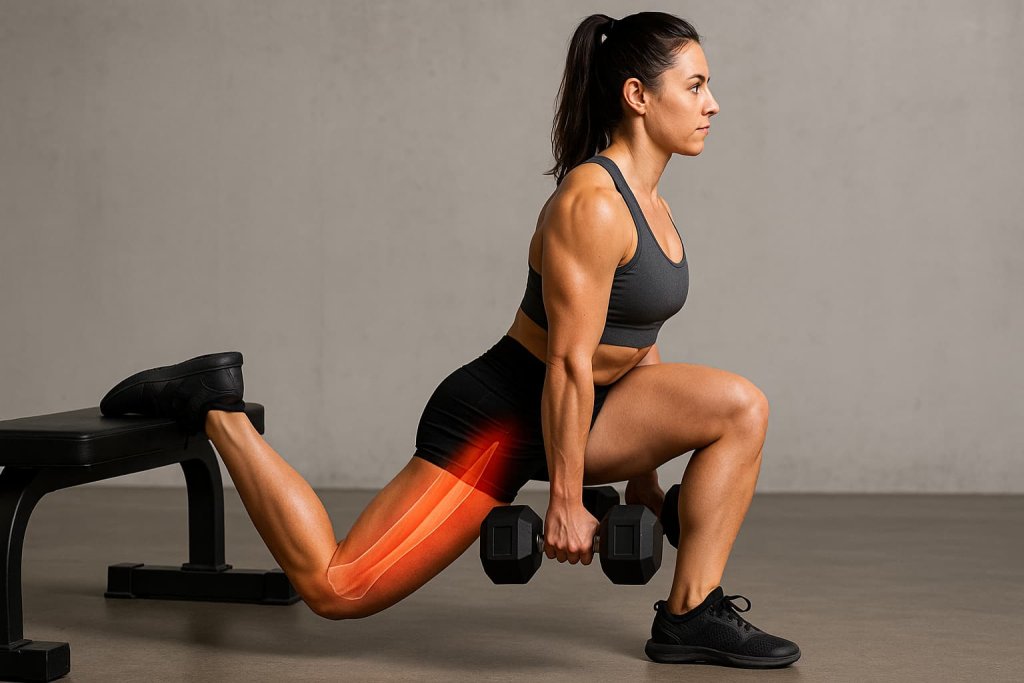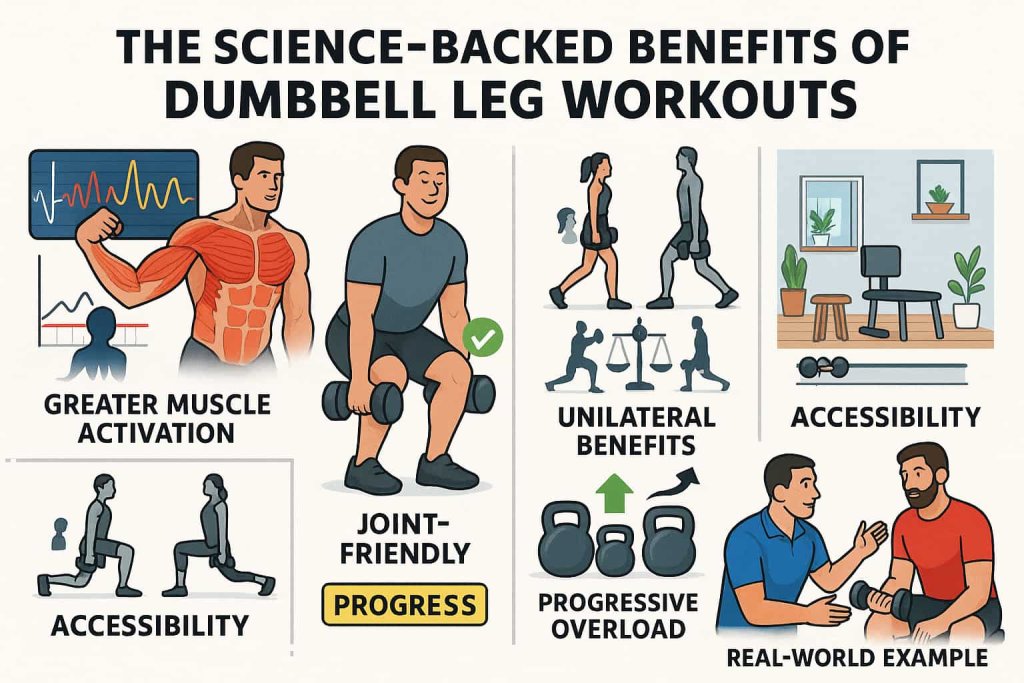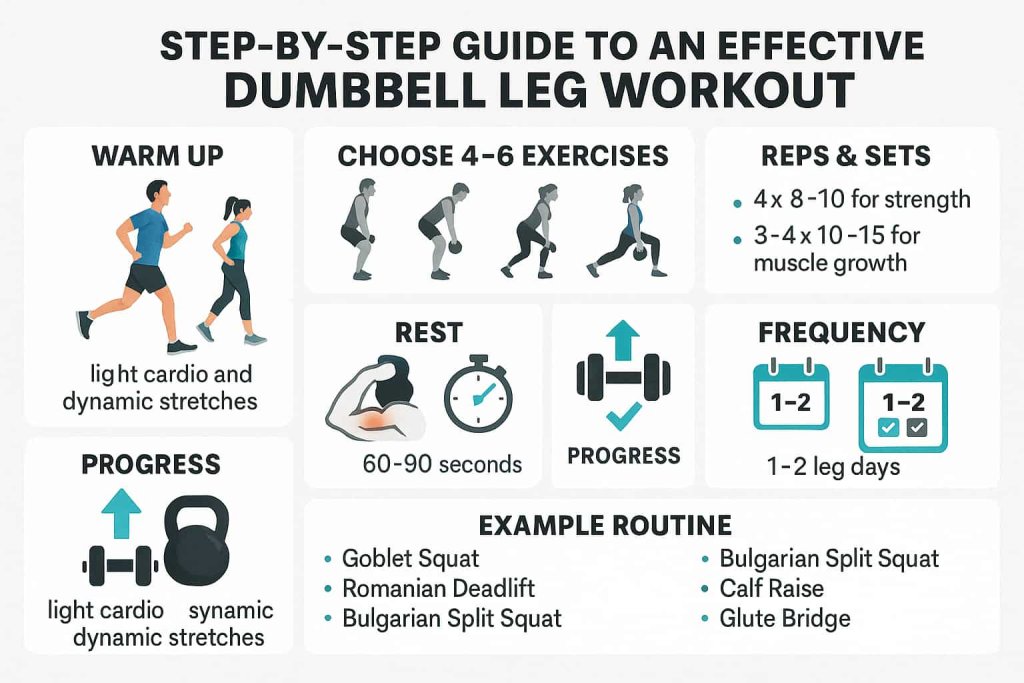You can sculpt powerful, balanced legs using only dumbbells—no machines or barbells required. The 15 dumbbell leg workouts in this guide are not only science-backed and trainer-approved, but also ideal for all levels, from beginner to advanced. Research shows that well-structured dumbbell routines are highly effective for building muscle, improving functional strength, and preventing injury—while being accessible at home or in any gym. If you want to maximize lower-body results safely, efficiently, and affordably, mastering these exercises is essential.

Dumbbell training for legs brings unique advantages: it improves muscle activation, enhances balance and stability, and allows unilateral (one-legged) work to fix imbalances and prevent overuse injuries. In this article, you’ll get step-by-step instructions, pro tips, the latest research, and practical answers to common questions.
Why Use Dumbbells for Leg Workouts?
Science-Backed Benefits

- Greater muscle activation: EMG research shows dumbbell moves like goblet squats and lunges engage more stabilizer muscles than machines.
- Joint-friendly: Dumbbells reduce spinal and knee stress compared to heavy barbells, making them safer for most people, especially beginners or those with joint issues.
- Unilateral benefits: Dumbbells are perfect for single-leg work (lunges, split squats), which can reveal and fix left-right imbalances—important for injury prevention and athletic performance.
- Accessibility: No squat rack or gym membership needed—just a pair of dumbbells and a small space.
- Progressive overload: You can gradually increase weight or add advanced variations, making dumbbell training suitable for lifelong progress.
Real-World Example: Physical therapists and strength coaches often use dumbbells for athletes recovering from knee or hip injuries, since the lower weights and natural movement patterns minimize risk while building functional strength.
The 15 Best Dumbbell Leg Exercises (Trainer-Approved)
Below are the most effective dumbbell leg exercises, with practical guidance for each. Mix and match for complete lower-body development.
1. Goblet Squat
- What It Is: A front-loaded squat holding a dumbbell at your chest. Suitable for all levels.
- Muscles Worked: Quads, glutes, hamstrings, core.
- How To: Hold one dumbbell vertically at your chest, stand feet shoulder-width apart, squat down, elbows inside knees, keep chest tall, push through your heels to stand.
- Trainer Tips: Go as low as your mobility allows, keep elbows pointing down, focus on slow lowering for more muscle growth.
- Why It’s Effective: Goblet squats maximize quad and core activation, teaching safe squat form and depth.
- FAQ: Can I use two dumbbells?
A: Yes, but a single heavy dumbbell often feels more natural for beginners and supports better posture.
2. Dumbbell Romanian Deadlift (RDL)
- What It Is: A hip hinge movement that targets the posterior chain.
- Muscles Worked: Hamstrings, glutes, lower back.
- How To: Hold dumbbells in front of thighs, feet hip-width apart, soften knees, hinge at hips, push butt back, lower dumbbells to mid-shin, keep back flat and neck neutral, return to standing by driving hips forward.
- Trainer Tips: Keep dumbbells close to your body, don’t round your back, feel a stretch in your hamstrings.
- Why It’s Effective: RDLs have among the highest EMG activation for hamstrings and glutes, key for posterior chain strength.
- FAQ: Should I go to the floor?
A: No—lower only until you feel a stretch in your hamstrings and your back stays flat.
3. Bulgarian Split Squat
- What It Is: A split squat with your rear foot elevated on a bench.
- Muscles Worked: Quads, glutes, hamstrings, core.
- How To: Stand a stride’s length in front of a bench, hold dumbbells at sides, place rear foot on bench, lower back knee to floor, front thigh parallel, push up through front heel.
- Trainer Tips: Lean forward slightly to target glutes more, use a pad for your back knee if needed.
- Why It’s Effective: Bulgarian split squats activate quads and glutes intensely, while building balance and single-leg strength.
- FAQ: What if I lose balance?
A: Hold onto a wall for support until you develop stability.
4. Walking Lunge
- What It Is: A dynamic forward lunge, alternating legs, moving forward each rep.
- Muscles Worked: Quads, hamstrings, glutes, calves, stabilizers.
- How To: Hold dumbbells at sides, step forward, lower back knee toward floor, step up and bring feet together, repeat on the other side.
- Trainer Tips: Don’t let your front knee go past your toes, keep torso upright.
- Why It’s Effective: Walking lunges are a top functional exercise for overall leg strength, coordination, and core engagement (ACE Fitness).
- FAQ: Are walking lunges better than stationary lunges?
A: Walking lunges increase instability and coordination demands—both are excellent, but walking lunges are more challenging.
5. Reverse Lunge
- What It Is: A backward lunge, gentler on the knees.
- Muscles Worked: Glutes, hamstrings, quads.
- How To: Step backward, lower knee to just above floor, keep front knee over ankle, push back to start, switch sides.
- Trainer Tips: Step back farther for more glute emphasis, keep chest high.
- Why It’s Effective: Reverse lunges reduce pressure on the front knee, making them ideal for beginners or those with knee sensitivity.
- FAQ: Can I do these with knee pain?
A: Yes—reverse lunges are often better tolerated, but always consult your doctor or PT if pain persists.
6. Step-Up
- What It Is: A step onto a raised surface, focusing on one leg at a time.
- Muscles Worked: Quads, glutes, calves.
- How To: Hold dumbbells, step onto a bench/box, drive through heel, step down with control.
- Trainer Tips: Don’t push off the trailing foot—use the working leg, start with a lower box if you’re new.
- Why It’s Effective: Step-ups mimic climbing stairs and are widely used in rehab and athletic training for single-leg strength and balance.
- FAQ: What’s the best box height?
A: Knee height or lower—higher is harder, but don’t compromise form.
7. Single-Leg Romanian Deadlift
- What It Is: An RDL performed on one leg, challenging balance and glute/hamstring isolation.
- Muscles Worked: Glutes, hamstrings, core, ankle stabilizers.
- How To: Hold dumbbell(s), balance on one foot, hinge at the hips, back leg straight behind, lower dumbbell toward foot, keep hips square.
- Trainer Tips: Don’t rotate hips open—keep them parallel to the floor, start with bodyweight if balance is difficult.
- Why It’s Effective: Single-leg RDLs correct asymmetries and prevent injury.
- FAQ: Should I use one or two dumbbells?
A: Beginners may prefer one; advanced users can hold a dumbbell in each hand.
8. Sumo Squat
- What It Is: A wide-stance squat holding a dumbbell between the legs.
- Muscles Worked: Inner thighs (adductors), glutes, quads.
- How To: Stand wide, toes turned out, hold dumbbell with both hands, squat down, knees over toes, return up.
- Trainer Tips: Go slow and focus on stretching inner thighs, don’t round your back at the bottom.
- Why It’s Effective: Sumo squats target muscles rarely worked by standard squats, improving hip mobility and lower-body aesthetics.
- FAQ: Can I use a kettlebell instead?
A: Yes, both dumbbells and kettlebells work well for sumo squats.
9. Cossack Squat
- What It Is: A side-to-side deep squat for mobility, strength, and flexibility.
- Muscles Worked: Adductors, glutes, quads, hip stabilizers.
- How To: Stand wide, dumbbell at chest, squat deeply to one side, other leg straight, return to start, switch sides.
- Trainer Tips: Go as deep as flexibility allows, keep heel of working leg on the floor.
- Why It’s Effective: Cossack squats improve hip mobility, athleticism, and balance.
10. Curtsy Lunge
- What It Is: A cross-behind lunge for unique glute and thigh activation.
- Muscles Worked: Glute medius, quads, adductors.
- How To: Stand tall, step one leg back and across, lower into a lunge, keep chest high, return to start, alternate sides.
- Trainer Tips: Don’t over-cross—find a comfortable, stable position, keep knees tracking with toes.
- Why It’s Effective: Curtsy lunges activate the glutes from new angles, making them great for lower-body shaping.
11. Dumbbell Glute Bridge
- What It Is: A bridge exercise with a dumbbell for added resistance.
- Muscles Worked: Glutes, hamstrings, core.
- How To: Lie on back, knees bent, dumbbell over hips, drive through heels, lift hips up, squeeze glutes at top, lower slowly.
- Trainer Tips: Keep lower back neutral, pause and contract glutes for 1–2 seconds at the top.
- Why It’s Effective: Glute bridges are a top choice for glute activation, injury rehab, and improving athletic power (ACE Fitness).
12. Dumbbell Calf Raise
- What It Is: A simple standing calf raise with dumbbells.
- Muscles Worked: Gastrocnemius, soleus (calves).
- How To: Stand upright, dumbbells at sides, rise up onto toes, pause, lower down.
- Trainer Tips: Pause at the top for full contraction, do on a step for greater range of motion.
- Why It’s Effective: Standing calf raises are effective for building ankle strength and improving running, jumping, and balance.
13. Dumbbell Wall Sit
- What It Is: Isometric hold for quad endurance.
- Muscles Worked: Quads, glutes, core.
- How To: Lean against wall, knees bent 90°, hold dumbbells in lap, hold as long as possible.
- Trainer Tips: Keep back flat, knees over ankles, add weight or increase hold time for progression.
- Why It’s Effective: Wall sits build mental toughness and static quad strength—useful for endurance athletes and rehab.
14. Dumbbell Overhead Lunge
- What It Is: A lunge with dumbbells pressed overhead.
- Muscles Worked: Quads, glutes, shoulders, core.
- How To: Press dumbbells overhead, arms straight, lunge forward, keep core tight, return, switch legs.
- Trainer Tips: Use light weights until shoulder stability improves, don’t let arms drift forward or backward.
- Why It’s Effective: Overhead lunges challenge total-body stability, coordination, and balance, making them an advanced option.
15. Dumbbell Box Squat
- What It Is: A squat to a box/bench for depth and safety.
- Muscles Worked: Quads, glutes, hamstrings.
- How To: Sit back onto box/bench, keep chest up, stand up, squeezing glutes.
- Trainer Tips: Don’t bounce off the box; pause briefly before standing, choose a box height that allows thighs parallel to the floor.
- Why It’s Effective: Box squats teach safe squatting technique, help prevent knee collapse, and are great for beginners or those working on depth.
How to Build an Effective Dumbbell Leg Workout

Step-by-Step Guide
- Warm Up: Start with 5–10 minutes of light cardio and dynamic stretches.
- Choose 4–6 exercises: Pick 1–2 from each category (squat, hinge, lunge, calf).
- Reps & Sets: 4 sets of 8–10 reps for strength, 3–4 sets of 10–15 reps for muscle growth.
- Rest: 60–90 seconds between sets.
- Progress: Increase weight, reps, or sets as you get stronger.
- Frequency: Train legs 1–2 times per week, with at least 48 hours between sessions.
Example Routine:
- Goblet Squat – 4×10
- Romanian Deadlift – 3×12
- Bulgarian Split Squat – 3×8/side
- Calf Raise – 3×15
- Glute Bridge – 3×12
Frequently Asked Questions
- Can I build muscle with dumbbells only?
Yes! Recent research shows that dumbbells, when used with progressive overload, provide similar muscle activation and growth potential as barbells for most people. - How heavy should my dumbbells be?
Start with weights that let you complete all reps with good form but feel challenging by the last 2–3 reps. As you adapt, increase weight gradually. - I don’t have heavy dumbbells—can I still grow?
Yes—slow down the tempo, increase reps/sets, or use single-leg versions to maximize muscle tension with lighter weights. - What if I have joint pain?
Choose joint-friendly options (reverse lunge, goblet squat), focus on perfect form, and avoid exercises that cause discomfort. If pain continues, consult a health professional.
Research, Pricing & Updates
- Latest Studies (2024): EMG and biomechanical research confirm that dumbbell squats, lunges, and deadlifts provide high muscle activation and are suitable for all levels.
- Equipment Costs: A basic set of adjustable dumbbells (5–50 lbs) typically costs $80–$150; fixed pairs vary from $20–$70 per pair (Amazon, May 2024).
- Recent Policy: Fitness professionals and organizations now recommend unilateral and dumbbell-based lower-body training for injury prevention and muscle balance (ACE Fitness, 2024).
Conclusion
Dumbbell leg workouts are efficient, accessible, and proven by science and trainers to deliver real results—no matter your level or location. These 15 exercises offer complete leg development, balance, and functional strength for sports and daily life. Start slow, master your form, progress over time, and your results will speak for themselves.
